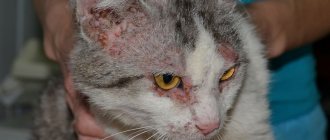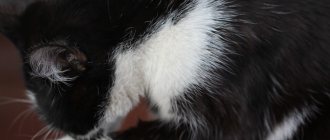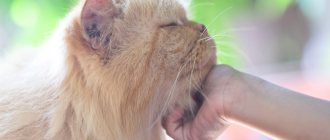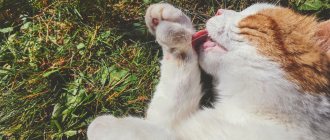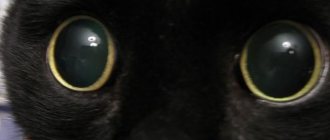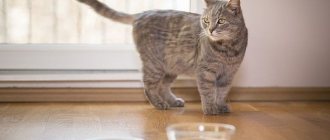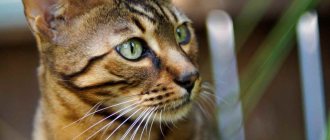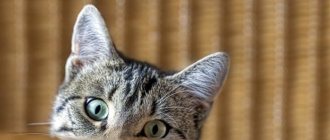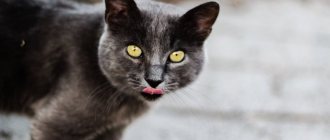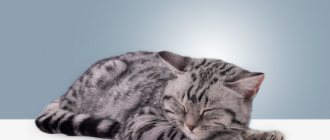Black spots in cats do not occur very often and may be the result of improper care. Sometimes such symptoms indicate disorders in the body that need to be identified as early as possible. A timely visit to a doctor will help determine the cause, and an integrated approach to treatment will eliminate the problem.
- 2 Causes and triggering factors
2.1 Why acne occurs in animals - video
- 4.1 Pharmacy and folk remedies
4.1.1 How to rid a cat of acne - video
What are blackheads in cats and why are they dangerous?
Blackheads (acne) are clogged sebaceous glands. The characteristic dark head occurs when sebum oxidizes. The appearance of such symptoms in an animal may indicate disturbances in the functioning of the body, the presence of parasites. Such a problem cannot be ignored.
Black spots can trigger the occurrence of furunculosis, which is characterized by a purulent process occurring in the inflamed sebaceous gland. This condition is dangerous for the pet’s health and can contribute to the spread of infection. Outdoor animals are most susceptible to acne, but comedones can also occur in indoor cats.
Blackheads in cats are caused by blocked sebaceous glands.
Malfunctions of the sebaceous glands also appear in completely healthy pets. If a cat likes to play outside, a small amount of dirt gets into the mouth and, mixing with sebum, clogs the duct. Most often, comedones are localized on the chin.
When acne occurs, the sebaceous gland becomes inflamed and expands. If the pore is not cleaned in time, bacteria will begin to multiply, which will cause the appearance of pus.
What are some skin diseases similar to acne in cats?
Before starting treatment , it is necessary to accurately determine the disease in your pet. Only a veterinarian will tell you the correct diagnosis after a thorough examination of the animal in the clinic. What appears on an animal’s face can indicate not only acne, but also other skin diseases. The symptoms of many diseases coincide, it is recommended not to draw hasty conclusions. The most similar causes in terms of symptoms:
- allergy,
- dermatophytosis condition,
- scabies,
- granuloma of the eosinophilic group,
- demodicosis reaction.
In order to completely exclude or confirm a fungal or parasitic group of skin lesions, a scraping study should be carried out. It is recommended not to jump to conclusions and make a diagnosis based only on symptoms. For an accurate diagnosis, laboratory data is required.
Causes and provoking factors
The cause of the problem may be the individual characteristics of the body. At the same time, the owner needs to properly care for the pet, which will reduce the number of black spots. An additional factor in the occurrence of acne in the chin area is that this area has the least amount of hair. This makes it easier for bacteria to get into the pores.
Additional factors:
- poor nutrition;
- hormonal disorders;
- decreased immunity;
- liver diseases;
- pathologies of the sebaceous glands.
When the sebaceous gland is blocked, the excretory duct may become inflamed, which causes pain.
The problem can also occur on the hips, elbows and eyelids. Inflamed sebaceous glands can cause discomfort to the animal, causing pain. The skin in the acne area becomes red and sometimes swells slightly. Chronic intoxication, which occurs as a result of infection of the body with parasites, can provoke the appearance of black spots. At the same time, the waste products of helminths contribute to disruption of the functioning of various systems.
Attention! If a cat has acne, it is necessary to check the condition of the paraanal glands, which are located next to the anus. If they are inflamed, you should definitely consult a doctor. Otherwise, acne will appear again and again.
Why acne occurs in animals - video
Symptoms, distinctive features, stages
Sometimes black spots on a pet's skin form and disappear without the owner noticing. This is explained by the fact that the mustachioer does not experience any discomfort and does not scratch the problematic part of the body. Acne goes away on its own thanks to a strong immune system.
However, repeated inflammation causes significant suffering for the furry ones. An attentive owner will notice the changes that occur on the animal’s body.
In addition, the behavior of the mustache also changes. He is constantly irritated, becomes restless, begins to refuse food, and is constantly itching. External symptoms may go through the following stages:
- Initially, redness of the skin appears.
- There are more pimples, and in appearance they look like dirt on the fur.
- The affected part of the body begins to swell and increase in size.
- Gradually, ulcers and inflammation of the follicles appear.
- Crusts of pus and blood form on scratched areas.
- The last stage is the loss of fur in the affected areas.
It is important to notice dermatological problems with your pet’s skin at the initial stage. If the owner takes action in time, the patient will get rid of the pathology much faster. Relapse is caused by incorrect or delayed treatment.
How to distinguish acne from other pathologies
It is important to be able to distinguish black dots from waste products of blood-sucking parasites and their larvae, as well as from droplets of dried blood that could appear as a result of trauma to the skin. Differentiating one condition from another is quite simple. You need to carefully try to detach the black lump. If it comes off easily from the skin and is dark brown in color, then it is dried blood.
Dried blood on a cat's chin looks like inflammation of the sebaceous glands
It is important to inspect the surface for scratches and small wounds. If the black dot has separated from the skin, but has a dense consistency and is difficult to press, then most likely these are waste products of ticks or fleas. Less commonly, these can be larvae of blood-sucking parasites. Acne is indicated by the inability to separate the blackhead from the skin. At the same time, it is as if soldered into the mouth of the sebaceous gland.
Flea larvae in cats can be confused with blackheads
If, in addition to acne, the animal has other symptoms, such as lethargy, appetite disturbances, diarrhea, then you should definitely consult a doctor.
The causative agent of parasitic infection is pinworm
Enterobiasis is caused by the pinworm parasite. This helminth is a roundworm belonging to the class of nematodes. It has some features in appearance. Females grow to a length of 9-12 mm, they have a “tail” - a pointed end. It severely injures the intestinal mucosa when the worm is in the body. Males are 2-3 times smaller than females, and their “tails” are curved in a spiral. Source: https://www.ncbi.nlm.nih.gov/pmc/articles/PMC2306321/ JP Caldwell Pinworms (Enterobius Vermicularis) Can Fam Physician. 1982 Feb; 28: 306–309.
Adult helminths live in the cecum and at the end of the small intestine. At night, females crawl out of the cecum through the anus. At this time, the person’s anal sphincter is relaxed, so nothing interferes with the worms. When the female pinworm emerges, she lays eggs in the perianal folds. There are a lot of eggs - up to 15 thousand. Having laid them, the female dies. The entire cycle of her life is about a month. The eggs are resistant to environmental factors and can remain viable for up to 3 weeks. They stain clothes and bedding.
After a few hours, the embryo from the egg becomes a larva, which itself begins to parasitize. This is how enterobiasis spreads. Pinworms can penetrate the thickness of the intestinal mucosa, causing the formation of granulomas. Sometimes worms crawl into the vagina, uterus and ovaries. Because of this, the female organs become inflamed.
Methods for eliminating comedones in pets
You can eliminate blackheads in a cat using an integrated approach to the problem. To do this, you should normalize the pet’s diet, eliminating everything harmful to its body, and also carry out deworming, that is, get rid of worms using one of the specialized drugs: Milbemax, Drontal, Dirofen, etc. You can also use topical pharmaceuticals for treatment. applications. Traditional methods will help complement therapy and make it more effective.
To eliminate acne, first of all, it is necessary to deworm your pet using the drug Milbemax or other similar products.
You should start eliminating comedones only after consulting a doctor, since the cause of the pathology can be serious disturbances in the functioning of the body.
Pharmacy and folk remedies
To eliminate acne in adult animals, the drug Percutan can be used. This medication has antibacterial properties, due to which it prevents the proliferation of pathogenic microflora and eliminates the inflammatory process. The medicine is available in the form of a solution for external use. It should be applied with a cotton swab 2 times a day to the affected areas of the skin. The course of treatment should be from 4 to 10 days.
Percutan has an antibacterial effect
Also, the area affected by blackheads can be treated with calendula tincture, which has anti-inflammatory and antiseptic properties. This product can regulate the functioning of the sebaceous glands, reducing fat production. The tincture should be used once a day. The most convenient way to apply the liquid is with a cotton swab. The treatment course should not exceed 4–5 days, since the tincture contains alcohol, which can dry out the skin.
Calendula tincture eliminates inflammation
For treatment, you can also use Furacilin solution, which is active against a wide range of microorganisms. At the same time, bacteria and inflammation are eliminated, due to which comedones gradually disappear. 1 tablet of Furacilin must be dissolved in 1 glass of warm water. Treat the affected area with the resulting liquid 3 times a day for a week.
Furacilin produces an antiseptic effect
It is also possible to use retinol (vitamin A) in the form of ointments and creams. These products include: Differin, Clenzit and others. These drugs should be used with caution, as they can cause severe skin irritation. Apply the ointment with a cotton swab in a thin layer every other day for a week. If your pet experiences itching and redness of the skin, then it is recommended to abandon this method of treatment.
Clensite helps eliminate acne, but can cause irritation
Another effective remedy for eliminating the problem is a solution of methylene blue, which can be purchased at a pharmacy. It soothes the skin by eliminating overactive sebaceous glands. You can treat the affected areas with this product no more than once a day for 3-4 days. If during this time the blackheads have not disappeared, then it is recommended to use another method, since methylene blue slightly dries out the skin.
Methylene blue relieves acne and heals skin
To get rid of comedones, you can also use Chlorhexidine. It eliminates bacteria and excess sebum, while blackheads decrease in size and then completely disappear. The solution should be used no longer than 4–5 days, because it can dry out the epidermis. Wipe the skin with this product 2 times a day using a cotton pad. It is advisable to do this after the pet has eaten.
Chlorhexidine should not be used for more than 5 days
For treatment, you can also use Elite shampoo, which is designed specifically for the treatment and prevention of skin diseases in cats and dogs. This product contains chlorhexidine, plantain and celandine extract, glycerin and provitamin B with allantoin. The shampoo is easily applied to the coat, foams and is washed off with warm water. After just a few uses, acne will disappear.
Elite shampoo is designed specifically for the treatment of skin diseases
In advanced cases, when a secondary infection occurs and suppuration occurs, it is recommended to use tetracycline ointment, which is active against a wide range of pathogenic microorganisms. This remedy should be applied to the site of inflammation 2 times a day. The course of treatment varies from 7 to 10 days. If at the end of therapy there is no result, then you should definitely consult a doctor.
Tetracycline ointment is active against a wide range of bacteria
An excellent folk remedy that helps solve this problem is tar soap. You can use it without fear. This remedy rarely causes allergic reactions, but it eliminates inflammation, fungal and bacterial infections, and also promotes tissue regeneration. Tar soap should be applied to the affected area once a day for a week. In this case, the skin should be pre-moistened with water. After application, you need to wait 5 minutes and then rinse off the product.
Tar soap does not cause allergic reactions
A good effect is produced by chamomile infusion, which eliminates inflammation and skin itching. You will need 1 tbsp. l. dry raw materials, which needs to be poured with a glass of boiling water and left for 1 hour. Then filter the liquid and apply it to the acne area 4 times a day using a cotton pad. The course of treatment is from 10 to 14 days.
Chamomile infusion helps you get rid of blackheads faster
Attention! Under no circumstances should you squeeze your pet's acne. Otherwise, you can provoke increased inflammation and the addition of infection, which will lead to the occurrence of furunculosis.
A friend has a white cat that has black spots on its chin. No one would have thought that animals could also have such a problem. A friend was scared at first because she thought it was not acne, but some kind of serious disease, so she immediately took her pet to the doctor. After examination, the vet said that these were just black dots. Prescribed Chlorhexidine and medicated shampoo. We managed to get rid of the problem in less than a week. Additionally, the doctor recommended paying attention to your pet’s diet.
How to rid a cat of acne - video
Diet food
In order to speed up your pet's recovery, it is recommended to normalize its diet. It is necessary to exclude everything fatty and fried from the cat’s menu, as well as milk and sour cream. It is best to feed your pet a specialized product suitable for a specific breed. In this case, preference should be given not only to dry options, but also to include in the animal’s menu boiled chicken and fish, carrots (which can be mixed with the main food), eggs, cottage cheese, as well as grass, which can be purchased at a veterinary store.
Boiled chicken should be included in your cat's menu
To prevent the problem from occurring regularly, it is important to avoid cheap food that contains a large amount of flavorings, preservatives, and salt, which increases the risk of urolithiasis. This product is very harmful to the pet's immune system. It is recommended to purchase food from the Royal Canin, Purina and other series.
Royal Canin - a line of quality cat food
It is also important that clean boiled water is always available to your pet. At the same time, for watering and feeding, it is better to give preference to iron or glass bowls, since plastic ones emit toxic substances that are harmful to the animal’s body. To strengthen the immune system and to reduce the risk of recurrence of acne, you can include special feed additives containing vitamins (Beaphar and others) in the menu.
It is better to use iron bowls to feed your pet.
To prevent malfunctions in the cat’s body, you should never give your pet bones, raw fish, sweets, as well as onions and garlic.
Can a kitten develop blackheads?
Comedones in kittens occur in isolated cases, since the body of most pets works smoothly up to 6 months. However, if such a problem does arise, then only non-aggressive means can be used for treatment. When eliminating black spots in kittens, you can use chamomile infusion, tar soap, and Furacilin. These products should be used once a day. The exception is chamomile infusion. It can be used 3-4 times a day. The course of treatment is often from 5 to 7 days.
Acne in kittens occurs in isolated cases
The occurrence of acne in kittens should be alarming, as this may be a sign of gastrointestinal dysfunction. It is important to monitor your pet's stool and appetite. If there are no alarming symptoms, then only local remedies can be used for treatment.
Key points of the treatment plan
It is not difficult to get rid of acne in cats at home. By following simple rules of hygiene, maintaining the most sterile conditions of the diseased area of skin on the chin, the likelihood of the spread and penetration of pathogenic microorganisms deep into the epidermis of the animal will thus be reduced to zero.
Treatment of a problem such as cat acne is based on the general treatment regimen for skin diseases presented below:
- Regular shampooing of the affected area.
- Before starting treatment procedures, a disinfectant wipe with 3% hydrogen peroxide is required.
- For long-haired pets, it is better to shave the hair in this area.
- The application of external preparations should be preceded by the dissolution of the stratum corneum of the skin.
- Treatment with antibiotics is usually necessary in complex cases when the area of the rash is rapidly increasing.
Self-medication is not the best solution
Among cosmetic products, as many owners note, lotions and scrubs help relieve itching. Compared to medications, which only a specialist should prescribe, the owner can purchase these on his own or select them from his own supplies. However, even with such seemingly safe remedies, you should be careful: adding allergic acne to the initial acne in cats can simply aggravate the course of the disease.
In any case, treatment of the disease should be under the full supervision of a veterinarian. Having a sufficient level of qualifications, a professional will objectively compare laboratory data with the information received during the examination.
The intensity of therapy for pet acne is determined by the frequency of rashes, the duration of the disease and its degree of neglect. For mild forms of manifestations, local treatment is usually prescribed, and for more extensive skin lesions, complex treatment is prescribed. At the same time, the main thing:
- Do not squeeze out blackheads and blackheads.
- Adjust your pet's diet, eliminating possible allergic irritants.
- Treat until complete recovery, since early relief does not guarantee final success.
Prevention measures
What measures to take to prevent blackheads from appearing again:
- Feed your pet correctly, giving preference only to high-quality and approved products.
- Do not give your animal strong medications without a doctor’s prescription.
- Deworm your pet once every 3 months.
- Monitor the functioning of the cat’s immune system by periodically giving your pet vitamins.
- If any malfunctions occur in the gastrointestinal tract, contact a veterinarian and do not delay treatment.
- Try to protect the animal from stress.
- If the animal often goes outside, it is recommended to bathe it once a month, and also wipe its paws regularly.
- Check your cat for fleas once a week. To do this, you should spread the fur in the area of the withers, belly and hips. If larvae are found, it is imperative to select them or use special means.
- If your cat always has food residues drying out on his chin after eating, it is recommended to wipe this area with wet wipes that do not contain alcohol or harmful fragrances.
If the problem arises from time to time and is an individual feature of the pet’s body, then fresh pumpkin juice can be used for prevention. They should wipe the areas where acne most often appears once a day every few days.
The appearance of blackheads in pets does not affect their general well-being if the provoking factor is harmless. However, the occurrence of acne can often be accompanied by unpleasant sensations. For this reason, it is recommended to begin treatment immediately after identifying the problem. Preventive measures will help prevent the recurrence of the pathology.
Instead of output
Cats with acne are likely to have varying amounts of comedones in the affected areas throughout their lives. These lesions may simply be a cosmetic problem that the owner may or may not treat, but may also predispose to a more problematic form in 45% of cases that requires periodic treatment.
Local (external) use of wipes, shampoos and ointments are quite effective. But if this does not help in your case, then there is “heavy artillery” - antibiotics, supplements. But to prescribe the drug, contact your cat with a veterinarian.
Material for the article was provided by veterinarian, dermatologist, allergist Olga Vladimirovna Chechora
Health and beauty to you and your pet!
Establishing diagnosis
You can collect anamnesis in advance to speed up diagnosis
To find out the cause of the formation of black spots, the veterinarian conducts studies such as taking an anamnesis, external examination, collecting material (scraping from the skin) and blood and tissue analysis. With the first point, you can greatly help the veterinarian if you collect information in advance about the past illnesses of the animal’s owners, nutrition, possible stress experienced in the coming days, as well as the pet’s lifestyle, and provide it to the doctor during the examination.
